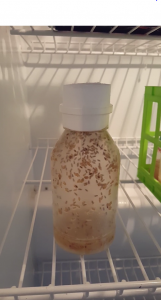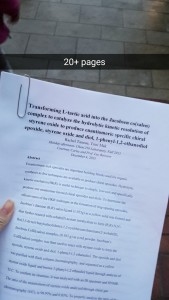Here’s the second part. And if you haven’t read the first part, click here.
JUNIOR
BIO 212 – Light microscopy
In this lab, we learned the different microscopy techniques (bright-field, dark-field, phase-contrast, fluorescence), because looking at small objects requires more than just placing it under a microscope. These techniques allow us to manipulate the microscope lens (changes the light) to better view certain things.
BIO 311 – Fruit Flies
In this lab, we analyzed the transmission of a trait and tested for genetic drift between small and large populations. Our test subjects being fruit flies, Drosophila melanogaster. To do this we observed multiple generations of fruit flies, looking at gender and the mutant trait (“white” eyes). To determine gender and if they had the mutant trait, we looked at them under a microscope. But to prevent our subjects from escaping, we would blast them with an air of CO2 to make them sleep.
CHEM 231 – Titration/Urine Vitamin Lab
Of all the labs, this was definitely the most memorable (and not necessarily in a good way). We had used the titration method to determine vitamin c concentration in urine samples (our urine samples). So, coming into lab that day, everyone was toting around a brown paper bag with containing cups of their urine samples. My lab partner and I looked at the difference between consuming Vitamin Water and orange juice. Although interesting, the smell was not pleasant.
CHEM 250 – Jacobsen’s Catalyst
This is a major project done in organic chemistry that is done around the second half of the semester. Just mention “Jacobsen’s” to any student who’s taken organic chemistry, and they’ll reply back with a groan and an “Ooh my god,” as they remember the long hours spent in lab, but mostly the time spent writing the report (20+ pages). However, after complaining about all the effort they had to put in, they’ll immediately talk about how awesome it was to do it. For me, there are so many cool things about this lab that I won’t be able to fit it all in. The biggest one would be the fact that we had the opportunity to produce a popular reagent used for enantioselective epoxidation of alkenes.
From this lab, I’ll definitely remember bright, highlighter yellow product we made.
*PLUS, Jacobsen actually visited a couple weeks back! It was an experience to be able to attend a couple of his lectures.
Honorable Mentions
CHEM 213 – titration and glassware calibration + glassware calibration


